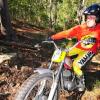| |
-
The TY175 rubber carby connection to the reed block is offset to the left relative to the reed block, presumably to place the carby further away from the exhaust than if it was straight. As a consequence of the offset built into the rubber part, the inlet path hole in the rubber part does not line up with the inlet path hole in the aluminium reed block. By fitting a rubber connection from an RD350, the holes line up, resulting in less restriction/drag in the inlet.
Further reductions in inlet drag can be gained by fitting a 26mm carby instead of the standard 22mm and using a better breathing airbox
-
that oil/petrol ratio should be OK.
If the tank has not been relined to protect it from the damaging effects of modern petrol, I wouldn't put any petrol in the tank unless you are sure that the petrol you are using has no ethanol in it
-
When it reaches the rev limit of 2500, does it die, 4 stroke, 8 stroke or misfire unevenly? Does throttle position make any difference to its upper rev limit?
-
Making it the same number of links as the one that comes off is a recipe for problems because the previous owner probably took links out as the chain and sprockets wore.
-
I think it is the sliders that are machined rather than the staunchions
The Norton sliders are machined to a larger ID
The modern sliders OD are machined down to fit inside the Norton sliders (and held there with glue)
-
on some other Montesas that share that same casting, that cover is the cover for the two-stroke oil injection pump
-
http://www.yamahaty.com/english/ty250en/technique250en.html
use the info for TY250 type 516
-
If this is twinshock TY250 forks, the sliding contact areas in the fork sliders are integrally cast with the sliders ie they don't have removable bushings. The seals John Cane sells work well. Some others do not. Standard oil volume is fine. The first model TY250 oil volume is slightly different to BCDE model forks. Oil weight is personal taste. I find the standard forks work fine with 10 WT or 15 WT fork oil. Spme people use 5WT. The springs may have become shorter if they are originals. New aftermarket springs are available.
-
Scorpa 2T was Rotax water cooled motor then Yamaha TYZ motor then Sherco motor
-
In Australia we ride trials in river and creek beds.
Some public land is protected from use by any motorised vehicle, but privately owned and privately leased land usually has few limitations relating to vehicle use
-
When Scorpas started coming out with the Yamaha 250 two stroke motor, I went to my local Yamaha shop and told them I would like to buy one from them but it had to come badged as a Yamaha like the one I had seen photos of in Japan - so I didn't get one
-
I would get the original casing repaired to reduce the potential for reassembly dramas
If it is just the hole that the kickstart creates in the magneto casing, I would not pull the motor apart to fix it, but would fix it while it was apart if I had to pull the motor apart for some important reason
-
The Alpina/Frontera/Pursang front hub does look very similar to a Sherpa T front hub, but it has a larger diameter brake drum. The similar appearance is why I suggested it. It is hard to tell the difference visually unless both wheels are close together. I can arrange a photo showing this if you like. There is a slight weight penalty with the bigger brake drum.
I have a couple of spare front Alpina wheels and brake plates I would be willing to sell if someone wants to make this change, but I am Australia so postage to overseas would not be cheap
-
yes I would think there is a pretty good chance of there being something unusual inside your 247 motor
seriously - if you are using a different LH crank casing it would be a good idea to do a test-assembly of the gearbox with the correct centre gasket before you fit the crankshaft
-
or use an Alpina/Frontera hub
-
maybe a kid pushed them in through the oil filler hole
-
Have just checked the parts book and yes the standard pilot jet is #25
-
I suspect they were leaving the option open of making a trail riding kit for the TY175, as was made for the TY250A. The DT100/125/175 footpegs of that time mounted on that sort of spline. As with the TY250A, it would require a very long brake pedal
-
This homemade one works well and does not damage the edges of the gear teeth
-
Flat spots like that are usually because the pilot jet is partly or fully blocked. I will look up the standard size pilot when I get home to my workshop. My memory is saying #25
-
looks like pieces of a broken L section piston ring (should not be inside the primary drive casing)
-
maybe someone shortened the aluminium part of the barrell (where the base gasket goes) to achieve the right deck height with a different piston or conrod, but forgot to also shorten the liner.
Unusual to have a tapered recess for the liner
Very interesting problem you have there
-
Tubliss system if fitted has two valve stems
-
just thought of another possibility - maybe that rebore was done out-of-square
-
It is also possible that the crankshaft is not sitting in the middle of the engine, causing the conrod to rub when the cylinder is held square by tightening the cylinder bolts.
I would also check that the crankshaft halves are not being squeezed inwards by incorrect shimming under the crank seal carriers.
|
|


